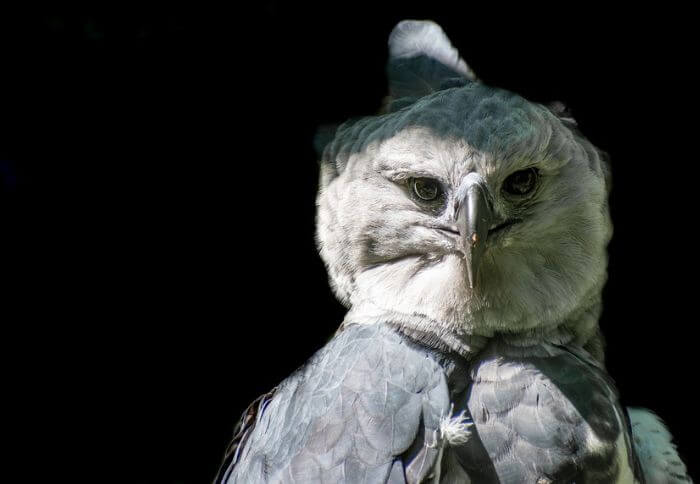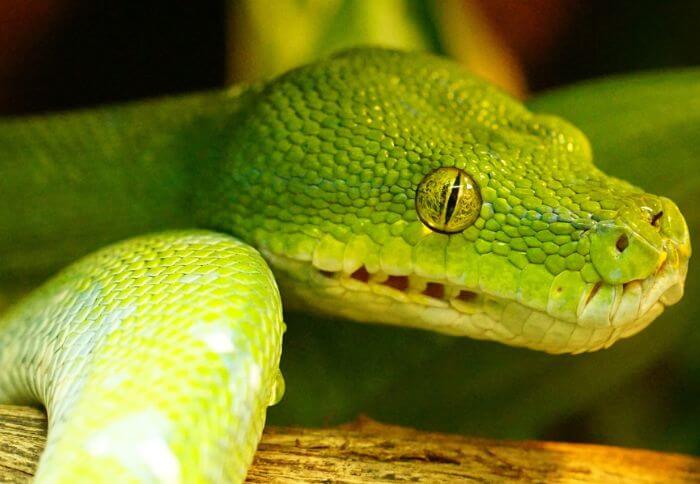What Eats Lizards in the Rainforest? (10 Predators)
Deep in the heart of the lush, vibrant rainforests, a complex web of life unfolds with each passing moment.
Among the myriad creatures that inhabit this enchanting environment, lizards hold a special place as elusive and fascinating beings.
But as much as these reptilian wonders navigate their way through the dense foliage, they are not exempt from being hunted themselves.
In this article, we embark on an exploration into the captivating world of rainforest ecosystems to unravel the mystery of what preys upon these agile and resilient lizards.
Common lizard predators
1. Eagles

The majestic harpy eagle, with its keen eyesight and powerful talons, is a formidable predator in the rainforest. As apex predators, eagles play a crucial role in maintaining the delicate balance of the ecosystem by controlling populations of smaller animals such as lizards.
With their aerial hunting prowess, eagles swoop down from great heights to snatch up unsuspecting prey with remarkable precision and speed.
Their ability to hunt lizards in the rainforest canopy showcases their unparalleled agility and adaptability in navigating through dense vegetation.
Not only are eagles skilled hunters, but they also exhibit remarkable intelligence and complex social behaviors.
2 Owls
Owls are majestic and enigmatic creatures that play a crucial role in the rainforest ecosystem as formidable hunters. With their keen eyesight, acute hearing, and silent flight, owls are expert lizard predators.
Their ability to swoop down on unsuspecting prey with deadly accuracy serves as a constant threat to lizards dwelling in the rainforest understory.
Interestingly, different owl species have evolved unique hunting strategies tailored to their specific environment and prey.
Some owls prefer to hunt from perches using stealth and patience, while others rely on active pursuit through dense vegetation. The diversity of owl species in the rainforest ensures that lizards have no respite from these skilled nocturnal predators.
In addition to controlling lizard populations, owls also contribute to the balance of the rainforest food web by preying on other small mammals and insects.
This interplay highlights how owls serve as integral components of the intricate web of life within the rainforest ecosystem.
3. Hawks
Hawks are formidable predators that play a crucial role in rainforest ecosystems as top avian hunters. With their keen eyesight and incredible speed, hawks are known for preying on a variety of creatures, including lizards.
Their aerial hunting skills enable them to zero in on potential prey from great heights before swooping down with precision and speed to capture their target.
In the rainforest, hawks feed on lizards such as iguanas, geckos, and skinks, using their sharp talons and beak to subdue and consume these agile reptiles.
The hunting behavior of hawks is not only fascinating but also essential for regulating lizard populations within the rainforest ecosystem.
As apex predators, hawks help maintain balance within the food chain by controlling the numbers of lizards and preventing overpopulation. Furthermore, their predatory activities contribute to the overall health and diversity of the rainforest by influencing the distribution of species and maintaining ecological equilibrium.
The interaction between hawks and lizards underscores the intricate dynamics at play in this biodiverse environment, highlighting the interconnectedness of all living organisms in the rainforest.
Related Read: Check lizards with large eyes
4. Peacock Bass
The peacock bass, an apex predator of the Amazon rainforest, is a formidable hunter known for its voracious appetite. With its striking colors and impressive size, it has earned the nickname the freshwater kingfish.
However, what many people don’t realize is that this majestic fish is also a skilled lizard hunter. Its powerful jaws and lightning-fast reflexes make it adept at ambushing lizards that come too close to the water’s edge.
This unique hunting behavior showcases the adaptability and opportunism of the peacock bass in utilizing various food sources within its environment.
As a top predator in its ecosystem, the peacock bass plays a crucial role in controlling lizard populations in the rainforest.
By preying on lizards, it helps maintain ecological balance and prevents overpopulation of these reptiles. The interaction between peacock bass and lizards highlights the intricate interconnectedness of species within the Amazon rainforest.
It serves as a captivating example of how different organisms coexist and interact in this diverse and complex ecosystem.
5. Green Tree Python

The green tree python, a mesmerizing species found in the rainforest, is renowned for its striking emerald coloration and arboreal lifestyle.
These stunning serpents spend their lives coiled around tree branches, patiently awaiting unsuspecting prey to wander into their clutches.
With their vibrant hues and slow swaying movements, they blend seamlessly into the lush foliage of the rainforest, making them formidable predators.
Though primarily known for consuming small mammals and birds, the green tree python also has a voracious appetite for lizards. Its unique hunting technique involves patiently stalking its prey before swiftly striking out with surprising precision.
6. Crows
Crows, often synonymous with dark omens and mischief in folklore, are actually highly intelligent and resourceful birds.
Found across various habitats, including rainforests, these clever creatures have adapted their diets to include a wide range of foods, making them efficient opportunistic feeders. In the rainforest ecosystem, crows play a crucial role as scavengers and predators, preying on small reptiles like lizards.
Their keen eyesight and sharp beaks enable them to hunt for these elusive prey amid dense foliage, showcasing their adaptability as apex avian predators.
Despite their black plumage and sometimes ominous reputation, crows are undeniably charismatic birds with complex social structures.
They are known to form tight-knit family groups and engage in sophisticated communication through an array of calls and vocalizations.
7. Puerto Rican Coqui
The Puerto Rican coqui, a tiny tree frog native to the rainforests of Puerto Rico, is a captivating creature that serves as both an emblem of the island and a vital component of its ecosystem.
With its distinctive co-qui call, this nocturnal amphibian not only captures the hearts of locals and visitors alike but also plays a crucial role in controlling insect populations within the rainforest.
As an abundant food source for various predators in the ecosystem, the coqui’s survival is vital to maintaining ecological balance.
Despite their small size, Puerto Rican coquis are faced with numerous predators in their rainforest habitat. From snakes and birds to large insects and small mammals, these frogs must constantly evade predation through clever camouflage and quick reflexes.
However, deforestation and habitat destruction present an increasing threat to these remarkable creatures, highlighting the delicate balance at play in rainforest ecosystems and the need for conservation efforts to protect them from endangerment or extinction.
8. Kestrels
Kestrels, with their keen eyesight, swift hunting skills, and impressive aerial agility, are formidable predators in the rainforest ecosystem.
These small but mighty birds of prey are known for their ability to hover in the air as they scan the forest floor for potential prey.
Their preference for open areas within the rainforest makes them well-suited to hunting lizards, as these reptiles often bask in sunny spots or scurry across clearings.
One fascinating aspect of kestrel behavior is their hunting strategy. Rather than relying solely on stealth and ambush like larger predators, kestrels utilize a high-speed diving technique called stooping to catch lizards by surprise.
This rapid and precise maneuver allows them to strike with remarkable accuracy and snatch up their unsuspecting quarry before it has a chance to react. The combination of speed, agility, and sharp talons make kestrels efficient lizard hunters in the dense rainforest environment.
9. Black Mamba
The black mamba, one of the most legendary and feared snakes in the world, prowls through the rainforests with unmatched stealth and deadly precision.
With its sleek black body and incredible speed, this venomous serpent strikes fear into the hearts of both predators and prey alike.
Hunting with a lethal combination of agility and ferocity, it preys on a wide variety of creatures including birds, small mammals, and even other snakes. Its potent neurotoxic venom inflicts a swift and merciless fate upon its victims.
In the intricate web of rainforest food chains, the black mamba reigns as an apex predator, holding sway over its domain with unchallenged authority.
Other animals that eat lizards
10. Komodo dragons
The mighty Komodo dragon, with its imposing size and impressive hunting skills, reigns as the undisputed ruler of the Indonesian islands.
Often referred to as modern-day dinosaurs, these creatures have earned a fearsome reputation due to their unique feeding habits. Despite being powerful hunters themselves, Komodo dragons will occasionally fall prey to larger predators such as wild boars and even other dragons.
This unexpected vulnerability adds an intriguing layer to their dominance in the animal kingdom.
Known for their exceptional sense of smell and sharp vision, Komodo dragons have evolved into formidable apex predators in their native habitat—however they also face threats from above.
Remarkably, large birds of prey are known to target young or injured Komodos—adding yet another dimension to these fascinating animals’ place in the food chain.
While it’s evident that Komodo dragons rule over many inhabitants of their ecosystem, it’s important to appreciate the delicate balance that exists between predator and prey in the rainforest environment.
Final thoughts:
The rainforest is home to a diverse array of predators that prey on lizards. From large snakes and birds of prey to small mammals and insects, there is no shortage of species that rely on lizards as a food source.
The intricate web of predator-prey relationships in the rainforest highlights the importance of maintaining balanced ecosystems.
As human activities continue to encroach upon these habitats, it is vital to understand and protect the natural interactions between species.
By promoting conservation efforts and sustainable practices, we can help ensure the survival of both lizards and their predators in the rainforest for generations to come. Let’s work together to safeguard these delicate ecosystems and preserve the rich biodiversity they support.
source:

Passionate animal enthusiast and skilled writer with a flair for captivating storytelling. With over five years of experience, I have crafted engaging content that sheds light on the fascinating world of animals.
Through my articles, blog posts, and social media campaigns, I strive to raise awareness about conservation efforts and promote a deeper understanding of the natural world.


